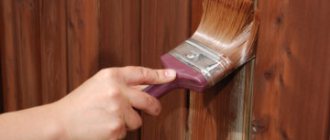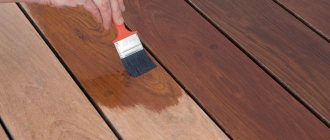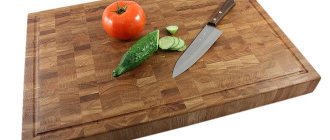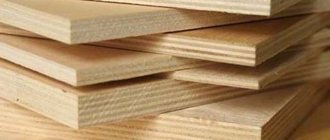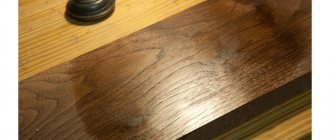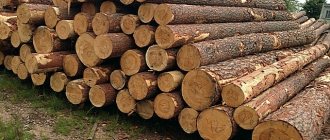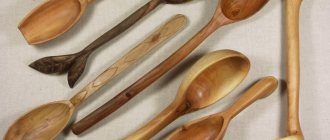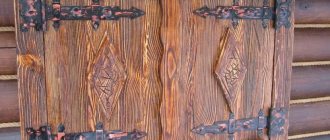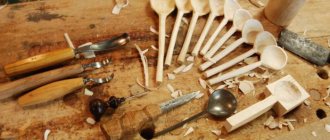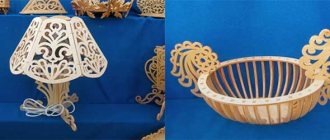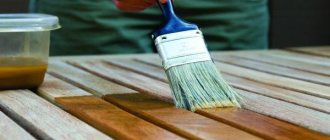Why do you need to varnish a wooden surface?
Wood remains a popular building material despite some disadvantages. Wooden coverings are durable, environmentally friendly and beautiful, hypoallergenic, look good in a variety of interiors and have good heat capacity (a wooden floor doesn’t even need to be insulated).
However, natural wood has a number of disadvantages: they are more difficult to install, and disruption of the process can lead to cracks and creaking. With changes in temperature and humidity, the boards can expand and shrink, which is why gaps may appear between them or the boards will rise like a house. The tree must be protected from insects and rodents, and the protective coating, paint and varnish must be regularly updated.
When applying varnish, a thin hard film is formed on the wood, which protects against water, UV rays and pests, and allows you to eliminate minor imperfections (splinters and splinters). The varnish also helps to maintain the natural color or get a new one.
Types of varnishes
The composition of varnishes includes resins, polymers, solvent and other substances. The composition may vary depending on the functions performed.
Types of colored varnishes Source sargorstroy.ru
When figuring out how to properly varnish wood at home , it is important to first choose a varnish. There are several types:
- Oily . They contain resins of synthetic or natural origin, which increase the strength of the surface. They form a transparent film with a yellowish tint. It dries slower than others, but you don’t need to wait for it to dry completely.
- Alcohol . It is made from resins dissolved in alcohol. The coating does not protect well from mechanical damage, but has good moisture-resistant properties.
- Polyurethane . They allow you to obtain a thin but mechanically resistant coating; it is also not afraid of water. They are used to process musical instruments.
- Acrylic . Made on the basis of polymer acrylic resins. They are resistant to the sun and durable, but can only be used inside houses. There are clear and colored varnishes.
- Nitrocellulose . Produced by dissolving nitrocellulose in organic solvents. Plasticizers are added to them to increase strength. They are applied in several layers and are often used to cover furniture. They dry out quickly.
Using a roller Source zawood.ru
- Alkyd . Manufactured from synthetic resins based on inorganic solvents. They are extremely durable and resistant to water, and therefore they are used to treat wooden walls outside the building.
Each species also has several varieties that differ in certain properties. This is important to consider when purchasing.
See also: Catalog of companies that specialize in paints and varnishes and related work
Manufacturers
Today, many well-known companies offer a wide selection of high-quality wood varnishes.
Italian products are in great demand. Borma Wachs has established itself as a high-quality and reliable manufacturer of products intended for processing natural wood.
The Italian brand Sayerlack offers more than 3,500 items, which fully satisfies the needs of woodworkers and furniture manufacturers.
The Finnish company Tikkurila is a popular manufacturer of water-based varnishes for coating parquet boards. It uses exclusively new technologies and computerized equipment to create high-quality and reliable products. The brand offers a wide range of wood varnishes that are characterized by increased wear resistance.
The Swedish company Bona has been offering high-quality water-based paints and varnishes that do not have a characteristic odor for several decades. The brand has its own research center, where innovative products are developed.
This center developed a unique varnish made from polyurethane particles Traffic . It allows you to give the coating increased wear resistance, as well as protect it from mechanical influences, as a result, Traffic varnish is used to cover parquet in high-traffic areas.
The German brand Berger offers a wide range of water-based parquet varnishes, characterized by excellent quality. Berger Aqua-Seal polyurethane varnish is in great demand, which not only has increased wear resistance, but also protects wooden parquet from chemical attack. The only exceptions are nitro solvents, since they can damage the structure.
The Italian company Vermeister is a well-known manufacturer of water-based polyurethane varnishes, which include two components and are designed to create a matte, semi-matte and semi-gloss surface. Aqua Play 2K varnish hardens in just four hours. The company offers products at reasonable prices.
How to choose the right one
Each manufacturer offers many varnishes that differ in properties. Each of them suits a specific situation.
Before covering the wood with varnish, the latter must be selected. When choosing, you should pay attention to the following points:
- Under what conditions can varnish be used ? If it is intended for outdoor use, it cannot be used indoors, as the product will most likely be overly toxic. It is better not to use varnishes for interior spaces on an external wall - it is unlikely to cope and will quickly peel off. It is important to take into account weather conditions, temperature changes, ultraviolet exposure, humidity, etc.
- Degree of wear resistance . For furniture, you can use a less resistant varnish, but for the floor of a walk-through room, you will need the most durable one, otherwise the layer will have to be constantly renewed.
Using a spray gun Source kwitka.com.ua
- Toxicity . Most products have a specific odor that can be unpleasant or harmful. Acrylic stamps have virtually no odor as they are made from non-toxic substances. If you need to treat wood in a nursery or in an apartment where people continue to live, it is better to choose the most non-toxic brands.
- Drying time . It can range from 30 minutes to several days. If you have little time for repairs, it is better to use quick-drying compounds.
- Presence of shine . The varnished surface can be glossy or matte. There are also colored varnishes.
In addition to the varnish itself, you need to choose a material for application. This can be a brush (thanks to the bristles, the composition will penetrate into small cracks in the wood), paint rollers (it is better to choose foam rubber), spray bottles (well suited for applying varnish over large areas). Small objects can simply be dipped into the raster or treated with a piece of fabric rolled into a roll.
Applying varnish
Surface varnishing is not difficult; beginners can easily master it. The main thing is to choose the right composition and follow the instructions, as well as do everything carefully and take your time.
Surface grinding Source parketnayadoska.com
Before figuring out how to properly varnish a wooden surface, it is important to know how to prepare it. The entire result often depends on proper preparation. You should not expect that minor defects will be “hidden” under the varnish. The thickness of the layer is too small, and therefore all the imperfections will be clearly visible.
All work must be carried out wearing personal protective equipment - thick gloves, a mask, a respirator. Clothing must completely cover the skin.
Grinding
Sanding is a mandatory preparation step. It can be omitted only in cases where it is necessary to preserve the texture and relief as much as possible.
To do this, use sandpaper with a grain size of 80-100. If the surface has been painted or varnished, remove the old layer with 40-60 grit sandpaper, or you can also use a belt sander.
After sanding, you should use a vibrating sander, which will remove smaller irregularities. It is necessary to sand in the direction of the grain, otherwise noticeable scratches will remain.
Finally, you need to carefully remove the dust using a vacuum cleaner or brush.
Applying primer Source gidpokraske.ru
Primer
When choosing what to treat wood with before varnishing, you should choose a primer. You can buy a ready-made primer or make it yourself. It is recommended to check with a specialist in advance whether the varnish and primer will be combined. If the mixtures turn out to be incompatible, the result will be unpredictable.
If the manufacturer has not indicated that the surface must be primed, this item can be skipped. If the packaging indicates that the wood must be primed, this should not be neglected, otherwise the varnish will quickly begin to fall off due to insufficient adhesion.
And yet, experts recommend not to neglect the primer and apply at least 1 layer. The primer allows you to get a perfectly smooth surface and reduce varnish costs, since the primer will clog all the small cracks and holes.
Wood varnishing - preparation for work
Before starting work, you should select the right materials, tools and provide suitable drying conditions. The room should be maintained at a constant temperature of around 20 °C; make sure that no other woodworking, another stage of repair or simple cleaning is taking place nearby. In general, make sure that there are no sources of dust of any nature, otherwise all this will end up on the drying layer of varnish, which will be very noticeable.
Whatever you cover, not only sand the surface, but also take the time to collect all the dust with a vacuum cleaner, wipe the surface with a cloth or swab with solvent. When working with varnishes, white spirit is most often used. To work with both varnish and solvent, you need to wear gloves on your hands, even if you think that you are working carefully. Choose carefully the brushes you plan to work with, this will prevent a lot of unnecessary hassle. The pile, first of all, must be natural. In addition, look at the bristles of the brush from the side, it should seem to be pointed towards the end.
Video description
You can see how to properly varnish wood in the video
A few tips and recommendations will help you in your work:
- Usually the varnish is applied in several layers, at least 3 – primer and 2 layers of varnish.
- The composition must be applied by brushing or rolling along the wood grain. This will help avoid noticeable streaks. The varnish is applied vertically with short cross strokes.
- You need to apply the mixture quickly, as most varnishes begin to dry immediately.
- After the first coat is applied, it is left to dry, then sanded with 120-grit sandpaper. This is done to remove strong streaks and ends of wood fibers that may have risen when wet and dried.
- After sanding, the surface is cleaned of dust and wiped with a damp cloth to completely remove dust.
- Then a second layer is applied to a clean and dry surface. If necessary, after it dries, repeat sanding and remove dust.
- If necessary, repeat the procedure several times. The penultimate layer is sanded with 200-400 grit sandpaper and the last layer is applied. If there is any excess left when applying it, remove it with a piece of cloth and solvent.
Consumption
In order to correctly calculate how many cans of varnish will be needed to treat a certain area, you should make some calculations.
First you need to pay attention to the criteria that play an important role when spending funds:
- Wood surface. Wood with fine pores always requires less varnish than surfaces with deep pores. For example, processing beech or pine will cost much less than painting ash or oak.
- Wood sanding quality. A well-polished surface always requires little varnish. For high-quality sanding of the material, you should use sandpaper with P100 grain. To create the second layer, use P220 sandpaper.
- Viscosity. Thick varnish will have a high consumption. To reduce it slightly, the first and second layers of application can be carried out with varnish diluted with a solvent. If the product is water-based, then you can add a little water to make it more liquid.
- Method of application. If you use spraying, the consumption will be minimal. Using a brush or roller increases the product consumption significantly.
On average, varnish consumption per 1 m² is 100–125 ml. It will take less to create a second coat of varnish. So, per 1 m² you will need only 80–100 ml. But the factors described above play a decisive role, so for an accurate calculation you can purchase a can of varnish, use it and measure the area. This will allow you to make a very accurate calculation.
Briefly about the main thing
Varnishing of wooden surfaces is used to protect and increase service life. Applying a thin layer can significantly improve performance.
There are several types of varnishes, they differ in composition and technical characteristics. When choosing, you need to pay attention to several important points.
Before applying varnish, it is necessary to prepare the surface - sand and prime. Primer is optional, but it is advisable not to neglect it.
Ratings 0
